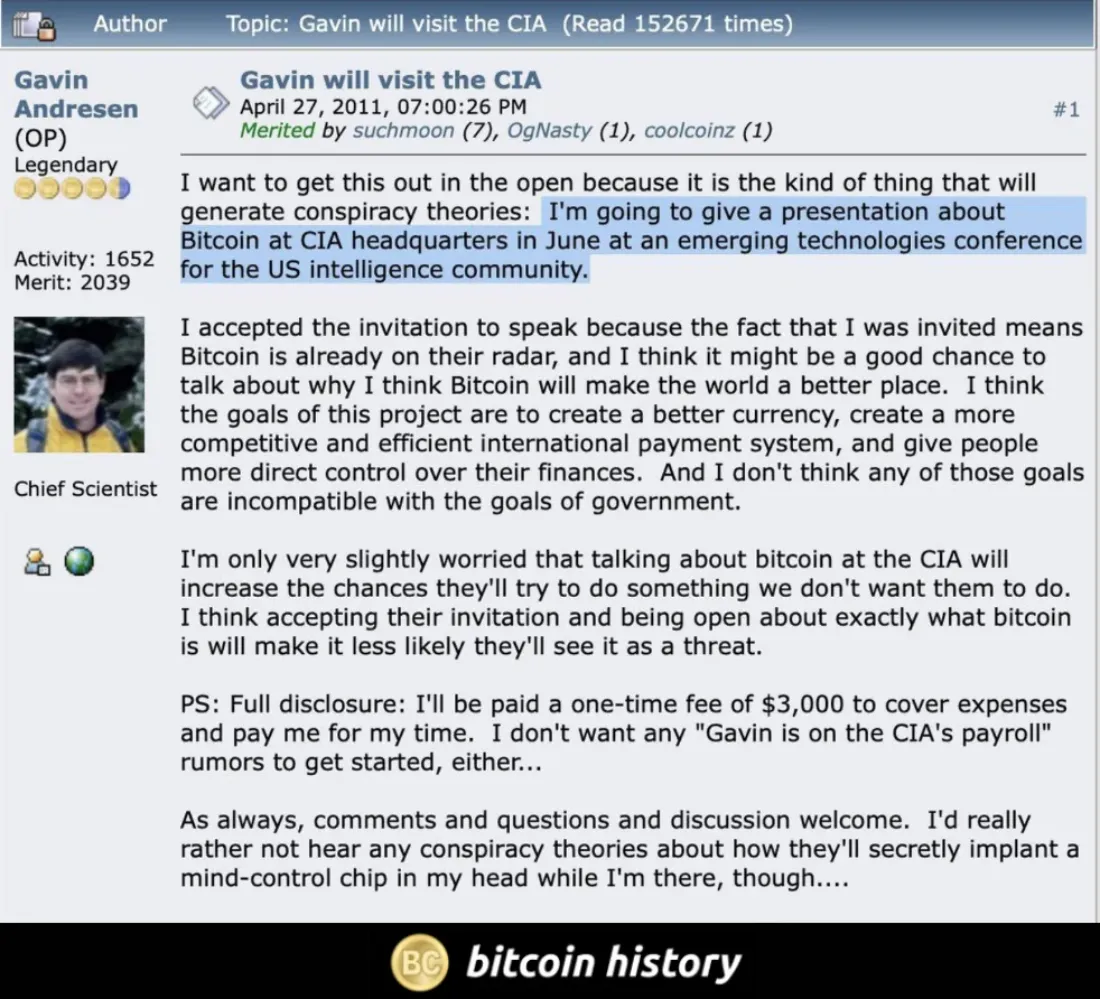BITCOIN SPOOKED
June 14, 2011
1BTC:$19.280000
- Artist
- Fact Date
- Fact #
- undefined
- Printing Specifications
- Paper / Stock
- Page Size
As Bitcoin entered the radar of national governments, it was inevitable the three-letter agencies would take note. The tech utilised, after all, a SHA algorithm developed with the aid of the NSA. When Gavin Andresen was invited to present on Bitcoin to the CIA, however, it sparked controversy, with some community members even blaming the event for prompting Satoshi’s exit.
In early 2011, Bitcoin was still in stealth mode. Its community was small, mainstream media coverage was virtually nonexistent, and governments weren’t panicking over its use cases and users. But while the majority of America’s 400-odd federal and governmental agencies didn’t yet have Bitcoin on their radar, one certainly did. And it was arguably the nation’s most notorious three-letter agency of all.
Born in the wake of the Second World War, the CIA is America’s primary foreign intelligence agency, tasked with information gathering through human intelligence (HUMINT), signals intelligence (SIGINT), and covert operations. It would be fair to say that the CIA has a chequered past on account of dubious operations like supporting Nicaragua’s Contras in the 1950s and domestic spying, uncovered by the 1970s Church Committee.
Nevertheless, for all its subterfuge and secrecy, few disputed the CIA’s abilities – particularly when it came to code. They were tasked with breaking it, after all, to intercept enemy communications, and also had a vested interest in robust encryption algorithms for defensive purposes. One such algorithm, SHA (Secure Hash Algorithm), was developed with the support of sister agency the NSA in the 1990s and it had since made its way into Bitcoin.
NSA researchers even authored a 1996 paper titled “How to Make a Mint: The Cryptography of Anonymous Electronic Cash,” which outlined a system for untraceable digital money using public-key cryptography. It’s clear that the concept of digital currency was on the intelligence community’s radar long before 2011.
Now that someone had gone ahead and created an implementation of electronic cash, what exactly was the CIA meant to make of this new digital currency that could be used by anyone – including foreign adversaries? To find out, they went straight to the heart of Bitcoin by asking its leading known figure in for a chat. Pseudonymous Satoshi was off-limits, but right-hand man Gavin Andresen was very much identifiable and available.

Into the Lion’s Den
“I want to get this out in the open because it is the kind of thing that will generate conspiracy theories,” began Gavin. It was April 27, 2011 and on the Bitcointalk forum, he had a surprising announcement to make. He was headed to CIA headquarters to give a talk on Bitcoin.
He had accepted the invitation, he explained, because “Bitcoin is already on their radar, and I think it might be a good chance to talk about why I think Bitcoin will make the world a better place…I think accepting their invitation and being open about exactly what bitcoin is will make it less likely they'll see it as a threat.”
Gavin added that he welcomed comments from other forum members on this decision, signing off: “I'd really rather not hear any conspiracy theories about how they'll secretly implant a mind-control chip in my head while I'm there.”
The thread was filled with comments, many supportive of the decision, some opposed, but with the general consensus being that at least Gavin would frame Bitcoin correctly – as a tool for good rather than a magnet for criminals.
Two months later, Gavin entered the lion’s den and gave his talk, which was well received. Afterwards, Gavin sold 1 bitcoin (for about $15 cash) to an agent who was intrigued by the demo and wanted a prop to “show his boss” how this new digital money worked. It’s unknown whether the agent held onto the now-precious bitcoin.
The CIA didn’t attempt to influence Bitcoin’s development – at least not overtly – and Gavin returned home with a positive impression of the place, even expressing wonder at the width of the hallways in the corridors of power. He later shared his presentation slides and appeared on The Bitcoin Show podcast to debrief the community on what happened.
With the talk delivered and no pushback from the CIA, that ought to have been the end of the matter. Only by the time Gavin delivered his presentation, something unprecedented had happened to Bitcoin: it had lost its creator who’d been an ever-present.
On April 26, 2011, Satoshi had emailed several of his fellow developers to inform them that he was moving on to other things – one day before Gavin’s CIA announcement. It was inevitable that subsequent Satoshi sleuths would draw a correlation between the two events. The notion that Satoshi fled Bitcoin due to the fear of being identified by U.S. intelligence is certainly dramatic. But despite the curious timing, it’s unsubstantiated.

There are clear signs that Satoshi had already begun to plan his exit by late 2010. At most, the CIA incident may have redoubled his resolve to get out while the going was good. More likely though, he was already on his way out the door when Gavin made his bombshell announcement. And by the time Gavin gripped the podium at CIA HQ, Satoshi was long gone.
- Artist
- XXXXX
- BTC On this day
- June 14, 2011
- Market Cap
- $126,158,680
- Block Number
- 130,880
- Hash Rate
- 7.31 TH/s
- Price Change (1M)
175%
- Price Change (3M)
2141%
- Price Change (1Y)
385500%
